The ventilation system of a private house should ensure the flow of fresh air into all premises of the house and stimulate its renewal. The duct system and air inlets are called supply air vents. Air ducts and exhaust openings - exhaust. Everything seems to be simple.
But in practice, the question of the most effective ventilation system design is one of the most controversial. One of the most controversial points: is it possible to bring ventilation to the attic. It may be better to dispose of the waste and contaminated air mass directly, i.e. through the wall?
In the article presented by us, all aspects of the construction of a ventilation system for a country house are analyzed. We will introduce you to the regulatory requirements and the nuances of the organization. Our recommendations will help you decide on the most practical option.
The content of the article:
- SNiP requirements for ventilation systems
- Consequences of improper ventilation output
- Natural ventilation with access to the attic
- Combined ventilation outlet to the attic
- Inclusion of the attic in the ventilation system
- Supply and exhaust ventilation with a recuperator
- Condensation in the attic is not terrible
- Conclusions and useful video on the topic
SNiP requirements for ventilation systems
SNiP requirements can be considered redundant, but it is still necessary to comply. They clearly prescribe not only the minimum required air exchange for each of the premises, but also regulate the characteristics of each of the elements of the system - air ducts, connecting elements, valves.
The required air exchange is:
- for the basement - 5 cubic meters per hour;
- for living rooms - 40 cubic meters per hour;
- for a bathroom - 60 cubic meters per hour (plus a separate air duct);
- for a kitchen with an electric stove - 60 cubic meters per hour (plus a separate air duct);
- for a kitchen with a gas stove - 80 cubic meters per hour with one working burner (plus a separate air duct).
It is logical to equip the bathroom and the kitchen forced ventilation system even if the rest of the house is natural enough. The extraction of air from the basement is also often provided with a separate air duct to avoid the concentration of carbon dioxide, which is heavier than air.
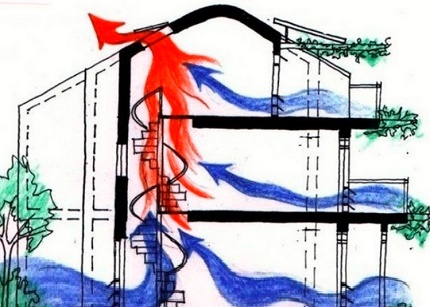
An infographic-style diagram of air circulation in a house gives an idea of the flow of air flows. It is very important to check the functionality of the system after installing the duct system.
Homeowners who are not ready to turn the roof of the house into a palisade of air ducts often think about how best to equip ventilation lines within the attic. After all, I would like the design to be not too bulky.
But is it possible to discharge the exhaust air through the roof structure and its supporting frame - the rafter system? And if this solution is valid, what is the best way to implement it? What equipment is required for the arrangement?
Consequences of improper ventilation output
If the project did not provide for the organization of a heated insulated attic, then, as a rule, in private houses the attic is an unheated room. The temperature in the attic is lower than in the house. When warm air from the duct, saturated with moisture from breathing, electrical appliances, heating systems, enters a colder room, the moisture condenses.
In the summer, this can lead to the formation of fungus and even rotting of the floors. In winter, moisture freezes and turns into frost and ice. There is nothing good about these snow and ice build-ups either. In winter, they contribute to the appearance of microcracks. In the summer they can melt and flood the attic.
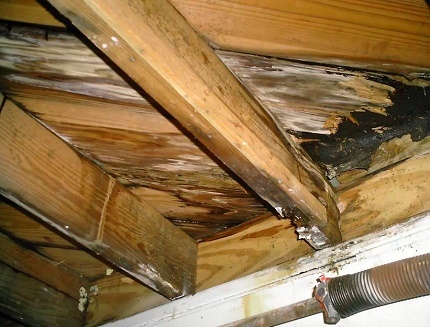
The air within the attic should be completely changed at least twice a day. Such a frequency of air exchange will exclude the formation of fungus, which irrevocably destroys the wooden components of the roofing system.
There is a way out: to bring ventilation to the attic in a private house, a number of important conditions must be met, these are:
- the presence of a ventilation outlet from the attic to the street;
- device in the attic space of the attic with its own ventilation system;
- installation of a mechanical ventilation system in the house - supply and exhaust with recuperatorinstalled in the attic.
Depending on whether the ventilation system is forced, natural or combined, its methods of output to the attic also differ.
Natural ventilation with access to the attic
Gravitational, it is also natural ventilation provides air circulation according to the principle familiar from school: warm air is lighter than cold air. Warm air rises through the exhaust ducts, which are located as high as possible. Colder air from the supply air ducts enters the house.
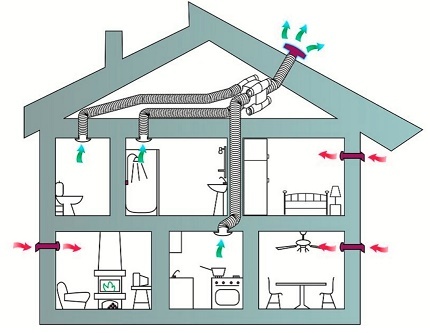
Ventilation ducts in a one- and two-story private house can be combined into one system only if there is a good ventilation system in the attic itself. This reduces the number of roof ducts
If in the attic and in the roofing pie there is a competently arranged effective roof ventilation, then the exhaust air systems can be combined in whole or in part.
The circulation and removal of the contaminated air mass within the attic will provide the following:
- fan risers;
- aerators (air duct with access to the street, forcibly providing constant air circulation in the attic);
- competent device of the roofing pie (the simplest is ventilation with the help of 2 gaps under the roof and above the rafters);
- roof valves that cut directly into the roofing system.
If a natural ventilation system is organized within the unheated attic, rational the solution is to combine all the ventilation pipes in the attic for output through a common ventilation mine.
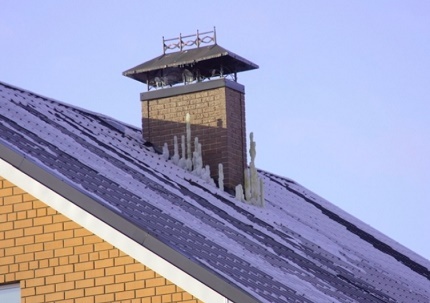
A single ventilation riser can solve condensation problems in the attic. Natural ventilation system closes on it
If the attic is adequately ventilated, condensation will not accumulate on it. Unfortunately, roof valves or attic gaps do not always provide it to the fullest.
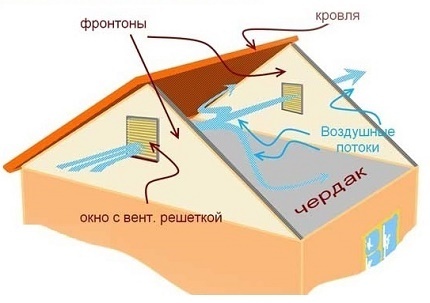
Ventilation of the cold triangle of an unheated gable roof (called a gable or gable) is carried out by arranging ventilation windows or openings with access to the street. This ensures sufficient air circulation in the attic.
Dormer and ventilation attic windows, which can be closed and opened, should provide more air circulation than other methods of natural ventilation in the attic. For example, inlet and outlet holes drilled in the gables.
Combined ventilation outlet to the attic
A good solution for the simplest ventilation system is:
- separate outlet to the attic kitchen exhaust pipes and a bathroom with forced draft;
- a separate outlet to the attic with further connection to the fan riser (or without connection) exhaust pipes from the rest of the living quarters.
This is the easiest and most effective way to provide ventilation at home without a supply and exhaust ventilation system with a recuperator.
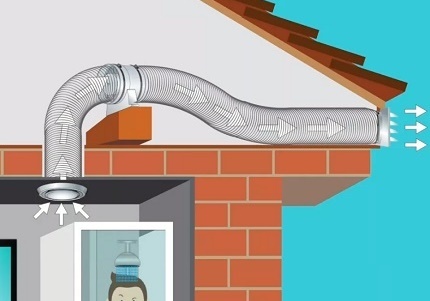
In combined ventilation schemes, a device for forcing air movement is installed either in the exhaust or in the supply openings
Fans of combined ventilation systems operate either for exhaust or supply. In the first case, fresh air enters itself, trying to fill the vacated space. In the second case, the portion injected from the street displaces the spent air mass from the room.
Inclusion of the attic in the ventilation system
An attic arranged instead of an attic is, in fact, another room. This is good from the point of view of optimizing living space, but it somewhat complicates the installation of the ventilation system in the traditional way.
There should be a ventilated attic space between the attic and the roof. Fresh air must be allowed to circulate freely in the roofing cake and within the attic or equipped attic.

Natural ventilation occurs due to the gravitational movement of the air mass. Cold air enters from the holes under the ridge of the roof, warm air leaves from the ridge hole, aerator
In the process of constructing a roofing pie, air vents are necessarily constructed - longitudinal ventilation holes. They start from the line of the cornice, end at the line of the ridge. Provided with the installation of the battens and counter battens on the rafter legs.
In the cornice zone, outside air enters these ventilation ducts. In the area of the ridge, the air flow comes out, taking with it condensate and household vapors that have penetrated from the living quarters into the attic space.
The ventilation system for the rest of the house is also led out into the attic. Exhaust ducts and risers from the house and from the attic can be combined and closed to an aerator. However, you need to be sure that there is sufficient air circulation.
Supply and exhaust ventilation with a recuperator
This is the easiest, most expensive way to bring ventilation to the attic. It is necessary to purchase a recuperator - a device that ensures the movement of the air flow while simultaneously adding a fresh portion of air and heating it to a comfortable temperature.
The entire circulation system is closed to a recuperator, the principle of its operation is quite simple. Heat from heating devices, boiler rooms is often wasted. So why not use it to partially heat cold air?
Cool air drawn in recuperator from the street, not only prepared by mixing with an already heated air mass, but also cleared of harmful and unpleasant impurities suspended in the air. In addition, the recuperative equipment is equipped with air heaters that heat the air streams.
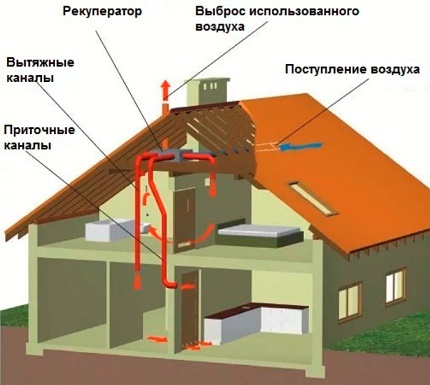
The schematic representation of a ventilation system with a recuperator in the attic looks quite simple. You just need to purchase a recuperator, mount and connect air ducts to it.
A prerequisite for the functioning of a system with an integrated recuperator is its compulsion. Air enters the room and is removed from it by two constantly running fans. Otherwise, the recuperator will simply not work, the device has too much aerodynamic resistance.
Valves and dampers are installed along the entire length of the air ducts for the correct distribution of flows. Additional screens must be installed at the inlet and outlet of the recuperator to prevent dust and grease from entering the device. The exit to the street is closed with additional bars from birds and insects.
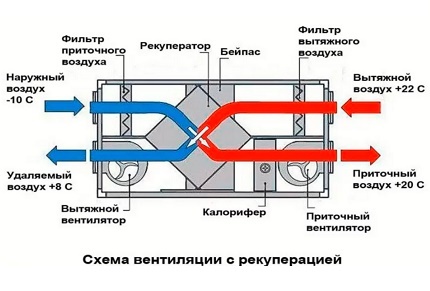
The recuperator cannot operate without fans. Thus, the presence of a constant source of energy in the house is of paramount importance. If electricity in a private house goes out regularly and for a long time, it is better not to use this system.
Modern recuperators can be programmed using the buttons on the control panel. These devices are even more expensive, but the ease of use makes them attractive.
And what about condensation, the main problem in the attic? Condensate does not accumulate in the recuperator, does not settle on the walls and beams of the attic, but quietly and peacefully flows into the sump located under the device.
In winter, in an unheated attic, this can become a problem, since in severe frosts, the recuperator power may not be enough. In this case, one more heating device can be installed next to the recuperator box.
Condensation in the attic is not terrible
The main enemy of ventilation systems in the attic is condensation. The cheapest way to deal with it is to bring the natural ventilation system to a well-ventilated cold attic. with full or partial closure of the system to a drain pipe or some other exhaust ventilation device.
If, instead of an attic in the house, an attic is equipped, one should not forget about integrating the attic into the ventilation system or creating a separate ventilation system for the attic and the rest of the house.
A forced ventilation system with a recuperator installed in the attic is the simplest, but also the most expensive way to bring the ventilation system to the attic.
Conclusions and useful video on the topic
Thoughtlessly bringing ventilation to the attic is not a good idea:
Installation guide for ventilation components in gable or gable roof:
Features of the device and action of natural ventilation in the attic:
Competently organized ventilation in the attic floor and in the unheated attic space will provide a standard microclimate in the residential area and extend the service life of structures.
However, when removing all ventilation components into the attic, building rules should be observed. Along with the exhaust air, condensate must be fully removed, from which elements of wood and metal are practically equally affected. They lose their bearing capacity from moisture.
Tell us about how and how you removed ventilation through your own attic or attic. Share useful information on the topic of the article that will help interested site visitors. Please leave comments in the block below, post photos on the topic, ask questions.


